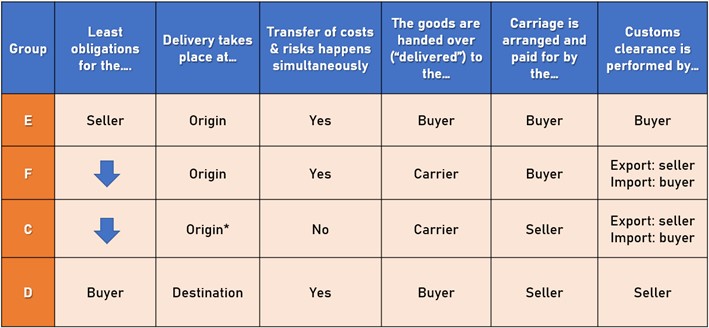A guide to “delivery” under Incoterms® 2020: the four groups
In previous versions of the Incoterms®, the International Chamber of Commerce conveniently divided the rules into four groups or families: E, F, C and D, where E and D were complete opposites and F and C were “intermediate” terms. However, the 2010 edition changed the former standards by classifying these terms not into groups, but according to the means of transport intended for each rule, largely due to the boom in containerization and multimodal transport. Additionally, the four customary categories fell into even greater disuse following the 2020 update, as the latter highlighted the importance of delivery and what it entails in A2-B2, with no need for any additional or obsolete criteria.
In spite of these changes, the traditional Incoterms® groups are still not only relevant, but also useful to comprehend how choosing a certain rule may affect delivery and, therefore, the entire allocation of costs and risks for both parties.
Under the only E rule, Ex Works, delivery takes place prematurely, at a point closest to the seller and even before the transport has begun. This way, the EXW sellers fulfil their obligations by merely providing the goods on their premises at the buyer’s disposal, hence any issues arising after formal delivery – as long as they fall within the Incoterms® scope – rest entirely on the buyer’s shoulders. In short, EXW represents the earliest delivery out of all of the Incoterms®, with the least number of obligations for the seller.
Both F and C terms have a lot of similarities, as they imply delivery at an early stage of transport by handing the merchandise over to a carrier at the designated place or port, or by placing the goods alongside a vessel (in FAS), thereby exonerating the seller from that moment onwards. This means, perforce, that under F and C terms the seller does not deliver the goods directly to the buyer or at the place of destination and, consequently, the rules are applicable to those agreements where parties are willing to arrange contracts of transport with a carrier. However, there are major differences between the two groups, namely:
- On the one hand, under F rules, the main carriage is arranged by the buyer. The seller organises pre-carriage up to a specified point, where the goods are formally delivered by handing them over to the buyer’s carrier, simultaneously transferring costs and risks to the latter; hence F rules will be followed by the named place or port of origin/shipment, where such transfer takes place. As an example, in FCA Shanghai, costs and risks are transferred at a specified place in Shanghai (e.g. container terminal).
- On the other hand, under C rules, the main carriage is arranged by the seller. These are the only Incoterms® in which transfer of costs and risks does not occur simultaneously, since risks are indeed transferred upon delivery of the goods, but costs are not. Therefore, the port or place that follows a C rule is not the place of origin or delivery but the place of destination, to which the seller must organise the transport of the goods (by hiring a third party carrier or a forwarder) and meet the expense. For example, in CPT Manchester, the seller bears the costs of transport as far as Manchester, which is the stipulated place of destination, but transfer of risks takes place when the goods are handed over to a designated carrier, such as a truck driver in Leeds.
When E, F or C rules are incorporated into a contract, once the goods are formally delivered the seller does not guarantee that they will reach the place of destination in sound condition, in the specified quantity or indeed at all, since the risk is always transferred after the delivery.
Whilst under the other terms it is the seller who normally completes the delivery in the country of origin, on the opposite side of the spectrum, D rules represent the maximum obligations for the seller and entail the latest form of delivery at destination i.e. at a designated point in the buyer’s country and place of choice. Hence, it is the seller who is in charge of the logistics and therefore obliged to ensure the transport and arrival of the goods, assuming all responsibility for loss or damage of cargo throughout the shipping process, which basically means – and contrary to the other groups – that fulfilment of the obligation to deliver under D rules depends on the safe and sound arrival of the goods in the country of destination, as specified in the sales contract. Furthermore, the seller also has the choice of whether to use his own means of transport or to hire an independent carrier, and he/she may even be obliged to clear the goods for import (in DDP), which would represent the maximum risk case for the seller.

Sources:
- ICC – The Incoterms® 2020 Official Book (ISBN : 978-92-842-0510-3)
- ShipHub, on https://www.shiphub.co/incoterms-2020/
- iContainers, on https://www.icontainers.com/es/incoterms/
Related links
Main menu



